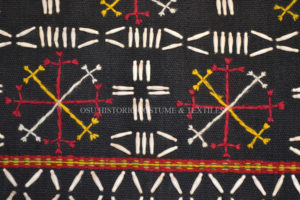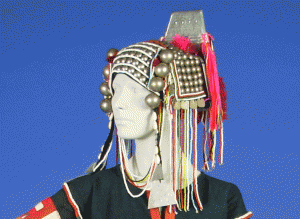October 1 – 31, 2004
Recent Acquisitions of the OSU Historic Costume & Textiles Collection features artifacts representing three of the Collection’s major strength areas:
- Designer couture and off-the-rack designer garments will be represented by such items as a 1996 silver metallic horizontal-striped evening gown by Badgley Mischka with rhinestones and glass beading at the neckline.
- Ethnographic or traditional folk dress will be represented by a variety of artifacts including embroidered everyday garments from the Hill Tribes of the Golden Triangle area of Thailand.
- The Collection’s historic fashion artifacts will be represented by such garments as a late 19th century print silk and velvet-trimmed day dress made by a Newark, Ohio, modiste.
The Collection offers exhibitions regularly to demonstrate to the public how the study of textiles and clothing at the College of Human Ecology is a holistic, interdisciplinary endeavor incorporating art, economics, history, and technology. The exhibition is open from Wednesday through Saturday each week, from 11 a.m. to 4 p.m. in the Geraldine Schottenstein Wing of Campbell Hall, 1787 Neil Avenue, on the Ohio State University campus, Columbus, Ohio. There is no cost for admission. Membership with the Friends of the OSU Historic Costume & Textiles Collection may be purchased to support maintenance of the Collection. For guided tours of 10+ guests, contact the Collection curator’s office at EHE-HCTCContactFMAG@osu.edu.
Designer Couture and Off-the-Rack Designer Garments
The exhibition will feature a selection of designer garments, both couture and off-the-rack. These fascinating items that, while not one of a kind, generally have qualities that set them apart from other off-the-rack garments, such as hand finishing, rich fabrics, and expensive trimmings. The exhibition will feature two such artifacts by the design duo of Badgley Mischka. The first, a sleeveless, silver evening gown from 1996, is made of a fluid silver metallic fabric, labeled as being 86% metal, and is woven in horizontal stripes. Beneath the slightly transparent fabric is a full length, double layer lining of silk that has been hand applied. The outer layer is flesh colored to convey an illusion of nudity beneath the gown. The scooped neckline and narrow straps are ornamented with rhinestones and glass beading in a flower motif. A photograph of actress Sharon Stone wearing this same style gown appears at the exhibition.
 A Badgley Mischka wedding gown from 1997 represents what the designers termed their new line of gowns for the sophisticated bride. Up until that point, many wedding gowns were ruffled and ornamented in the Victorian style. This long-sleeved sheath dress with a scooped neckline is of eggshell silk lace with flower motifs outlined in crystal beads from the neckline to mid-calf. From there to the end of the modest 2-foot train, the softly flowing lace stands on its own. A long row of satin-covered buttons marches down the back of the gown, concealing a hidden zipper that is the real closure. Four matching buttons ornament each sleeve at the wrist.
A Badgley Mischka wedding gown from 1997 represents what the designers termed their new line of gowns for the sophisticated bride. Up until that point, many wedding gowns were ruffled and ornamented in the Victorian style. This long-sleeved sheath dress with a scooped neckline is of eggshell silk lace with flower motifs outlined in crystal beads from the neckline to mid-calf. From there to the end of the modest 2-foot train, the softly flowing lace stands on its own. A long row of satin-covered buttons marches down the back of the gown, concealing a hidden zipper that is the real closure. Four matching buttons ornament each sleeve at the wrist.
A black evening ensemble by Karl Lagerfeld for Chanel represents another off-the rack designer artifact recently acquired by the Collection. Made for the fall 1999 season, the outfit consists of black silk crepe de chine trousers to be worn under a black, full-length coat. The wide left lapel of the coat is adorned with a black silk cabbage rose boutonniere. The cuffed sleeves and the front are ornamented with buttons bearing the Chanel logo. The black synthetic fabric of the coat is of special interest as it has a liquid or molten appearance, giving it a futuristic look perfectly suited to the turn of the millennium. At the same time, the modern-style coat has waist-level smocking in the back that produces a gathered effect almost resembling a bustle. The garment blends past and future styles to achieve a new concept in modern dressing.
An evening dress of stiff silk taffeta by Yves St. Laurent represents designer couture wear that is custom made for the purchaser. This dress, created in 1990, was donated to the Collection by Terre Blair Hamlish, former Columbus television anchorwoman and wife of Marvin Hamlish. The fabric is a warp printed silk, with the weft threads of the fabric being the same white as the background. The warp threads form the design of the fabric–purple and fuchsia roses with green leaves. This technique gives the flowers an iridescent quality that adds to the softness of the dress and the blurred edges of the design. The scooped neckline leads to sleeves that puff at the shoulder, then taper to a slim silhouette at the wrist. The long-waisted bodice blossoms into a cascade pouf skirt, self-lined so that no reverse side of the fabric shows. The skirt starts at knee length in front and cascades to a longer length in the back. The dress closes with a hidden zipper in the back and hidden zippers at both wrists.
Ethnographic or Traditional Folk Dress
The Collection’s selection of ethnographic or traditional folk dress and textiles will be represented in the exhibition by several items from the Hill Tribes in the Golden Triangle of Thailand. Each of the tribes uses color in the ornamentation of its garments as an identifying characteristic. For instance, a woman’s loose blouse from the Karen Tribe, simple in construction for everyday wear, is of hand-woven, hand-dyed black cotton. The creator contrasted the simple construction of the garment with intricate decoration in white, yellow, and red stitching. Job’s Tears seed beads are arranged with the stitching in geometric patterns, in addition to supplemental weft weaving in red bands. The colors black, yellow, white, and red have significant meaning in many Asian cultures. For some, red symbolizes the male or right, and black, the female or left. When used together, the two halves create a complete whole. The colors also symbolize the four cardinal points of the compass: black=east, white=north, yellow=west, and red=south. When used together, these colors again create a symbolically whole piece.
A simple pair of women’s trousers for everyday wear from the Yao Tribe are heavily embroidered with cross-stitched geometric patterns dominated by the colors pink, fuchsia, purple, and red. Again, the simple cut and construction of the garment are contrasted by the extensive hand work devoted to the embroidery. The people of these tribes take pride in their ability to create complex ornamentation and spend much time in creating their garments.
The headdress of a married woman from the Akha Tribe is replete with rows of metal balls across the forehead and top of the head. Four large silver balls adorn the temple on each side. An embossed metal trapezoid rises from behind the head, a decoration that is not present in the headdresses for unmarried women. Long strings of colored seed beads hang down on each side of the face, and strands of thread and dyed chicken feathers also add color.
Historic Fashion Artifacts
Another historic fashion on display is an 1897/98 day dress for visiting, traveling, or shopping. Made of a feather motif print silk with eggplant velvet trim, it has a boned, decorative bodice with pleats radiating from the collar to the velvet lapels. It closes up the front with hooks and eyes. The sleeve starts with a big puff at the shoulder and narrows to a tight fit, finishing with a velvet band. The separate bell-shaped skirt has three gores. Apparently the fabric was not wide enough to accommodate the skirt pattern pieces, because perfectly matched piecing has been added to extend the width of the fabric. The design of the added pieces is painstakingly matched to form complete feathers. An interesting feature is the label printed inside the back of the bodice. It reads, “Miss Ella Taylor, Modiste, Newark, Ohio”
The OSU Historic Costume & Textiles Collection is a repository for material culture artifacts that capture the aesthetics of eras, places, and stylistic trends in wearable and interior fabrics. It is used by the College of Human Ecology’s faculty, staff, and students as a teaching and research resource tool, similar to a research library, with an average of more than 800 artifacts being borrowed to show to students in classes each year to illustrate learning objectives. Exhibitions serve as learning experiences for undergraduate and graduate students and as outreach opportunities to educate the public.
Annual attendance is between 1,500-2,100 patrons, including 15 to 30 tour groups ranging in age from middle schoolers to senior citizens. Academic researchers request access to specific items or examine the database for scholarly study. The Collection has been the inspiration for 10 theses/dissertations generated since 1992.
For more information, please contact the Historic Costume & Textiles Collection at (614) 292-3090 or e-mail us at EHE-HCTCContactFMAG@osu.edu.



